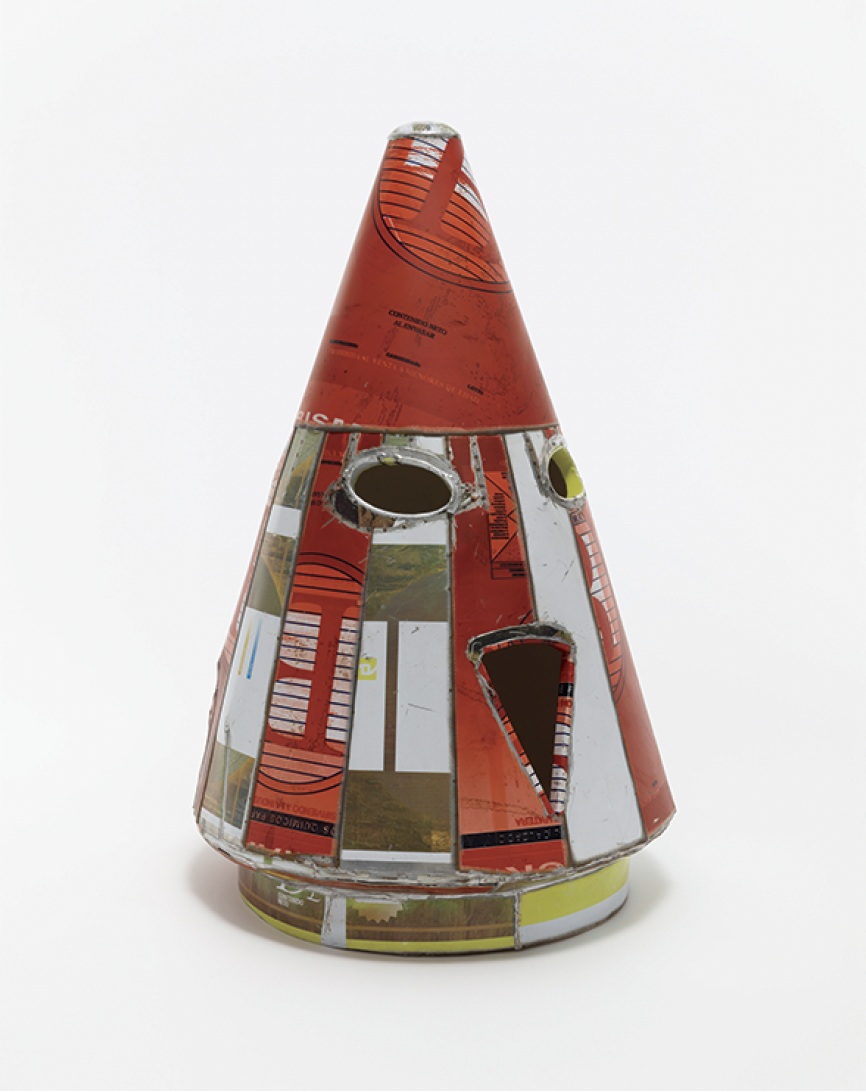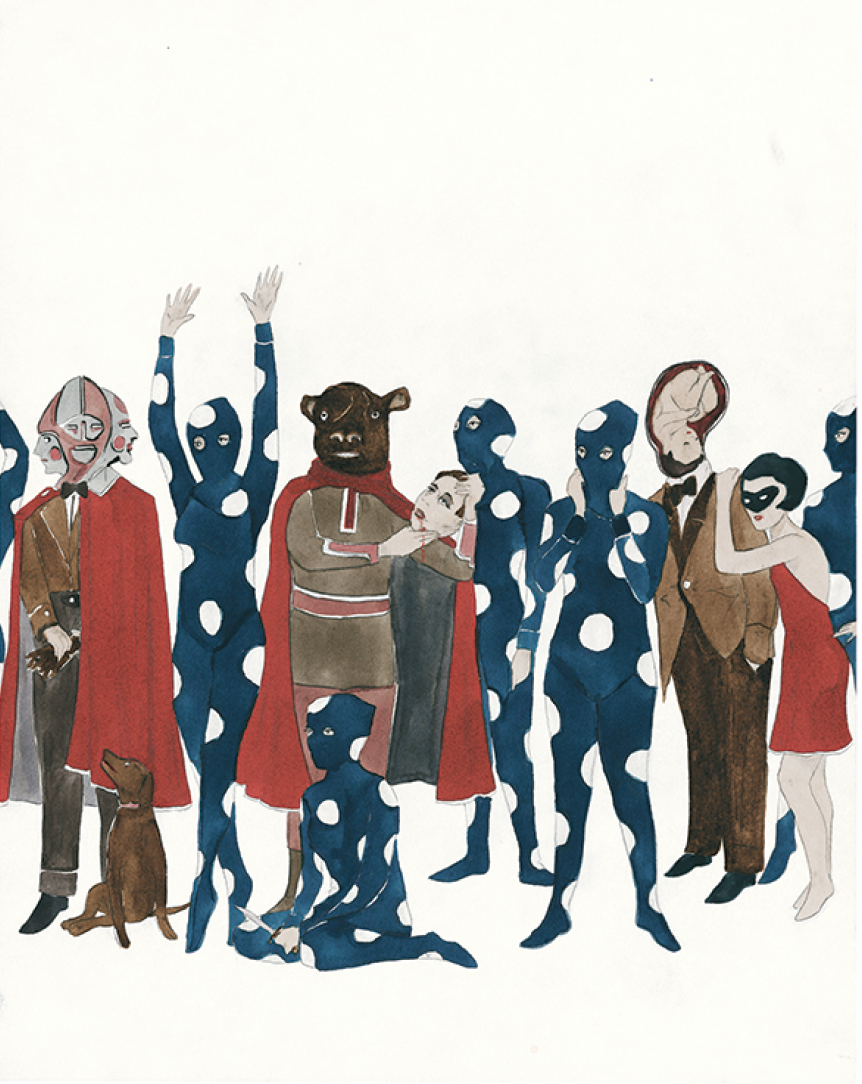Marcel Dzama
Imagine you are as successful as Marcel Dzama. Do you just carry on with more characters, more free association, more media? Or do you look for extra depth, either in the sense of profundity or through the close examination of a specific theme? Dzama’s show at the recently opened London branch of David Zwirner Gallery suggested that he’s looking for both deeper content and more focus by concentrating on chess as his literal and metaphorical subject. I think he’s ended up pretty much where he started, but the exhilarating ride of “Puppets, Pawns, and Prophets” is none the worse for that.

Marcel Dzama, Death Disco Dance Defense, 2013, collage on paper, 12 x 9 inches. Courtesy David Zwirner, New York/London.
There’s certainly no reduction in quantity: scores of drawings, several paintings and collages, three films, a dozen sculptures, some well-stocked cabinets and four teeming dioramas of cut-out figures—not to mention storyboards and pianola rolls. Nor is there any narrowing of content: Dzama’s approach is additive, differing from his heroes Joyce, Duchamp and Picabia, who tended to move on from one mode to the next. The results remain seductively baffling and nostalgic. Originally that nostalgia could be attributed to the peculiar atmosphere of Winnipeg, where he grew up and where the isolating factors of geography and extreme weather seemed to feed into his distancing of time. Here, in this new work the main source is art history. Perhaps that points to what Deborah Solomon’s catalogue essay suggests is “nominative determinism,” i.e., Dzama responds to being given a name, Marcel, “with an instant, ineradicable link to the European avant-garde”—Duchamp in particular.
Mexico is prominent in the mix. The short film, The Infidels, in which a dance with guns turns into a bloody battle, takes off from Dzama’s now-iconic spinning black-masked Kalashnikov-wielding revolutionary women. They themselves are derived from the Chiapas resistance, and much of the work in this show was made in Guadalajara, including Death Disco Dance, 27 monitors-worth of choreographed chess action played to a soundtrack of drums and birdsong.
Dzama has always made, as Solomon puts it, “art that bleeds,” and chess provides a natural means of playing out conflict. Dzama’s battles have tended to suggest libertarians set against authority, so it’s no surprise to see a pawn triumph at the end of the most complex film, the four screen, 14 minute Sister Squares. That film intercuts chess players in a park, moves played out on a diagrammatic board, bulbously papier-mâché-headed spectators looking on as if at gladiatorial entertainment, a mariachi band and ballet dancers dressed as chess pieces. The chess emerges from Duchamp’s famous love of the game as much as from Dzama’s own enthusiasm: the look of the work, however, owes more to Oskar Schlemmer.
The chess itself is clunky: the board is set up the wrong way round, the moves have little competitive logic, Duchamp’s actual concept of sister squares (a geometric theory that systematizes aspects of king and pawn endings) is not actually featured. Where the chess theme does score isn’t in representing the game or in delivering profound, or even comprehensible messages about life and death, but as a basis for design; as a means of moving between reality and representation, and as a language.

The Queen’s Head, 2012, ceramic and tin, 23 x 14 inches. Courtesy David Zwirner, New York/London.
The pawns’ black and white costumes provide a design thread that runs throughout the show, interacting with chess and non-chess elements alike. Their suits also carry the suggestion that the world isn’t as simple as binary chess divisions might have it: there’s some black in white, and some white in black. The most striking new forms are sculptures with another Mexican connection: dissatisfied with how his ceramic versions of the chess pieces came out, Dzama covered them with tin facets cut from various brightly labelled containers which were lying around in his Guadalajaran studio.
Each of the figures’ heads is accompanied by a drawing that shows it being worn in action, as if to prove the reality of the scenes by the actual evidence. In the films, chess pieces come to life and we see, as the title of one of the dioramas has it, If You Think This is Just a Game, You’re Wrong. Perhaps, given the inequality among chess pieces, we can draw parallels between our fates and that of most pawns.
One of chess’s attractions is how readily it is notated, which has facilitated a rich literature. Dzama adds chess notation to several drawings, enacting a neat parallel to the strangeness of his own content: hard to fathom for the outsider, yet with an underlying appearance of potential sense—though whether you can learn to “speak Dzama” the way you can learn to play chess and record it is another matter.

Myth, Manifestos, and Monsters (detail), 2013, ink, graphite, and gouache on paper. Four-part work, overall: 14 x 44 inches. Each page: 14 x 11 inches. Courtesy David Zwirner, New York/London.
Ultimately, the show is the Marcel Dzama Theme Park rebooted with chess, Duchamp and Mexico, and as such is about the infinite and mysterious potentialities of the world. There are said to be more possible games of chess than there are atoms in the universe, and one suspects something similar of the number of possible—and captivating—works by Marcel Dzama. ❚
“Marcel Dzama: Puppets, Pawns, and Prophets” was exhibited at David Zwirner Gallery, London, from April 6 to May 11, 2013.
Paul Carey-Kent is a freelance art critic in Southhampton, England, whose writings can be found at <paulsartworld.blogspot.ca>.

